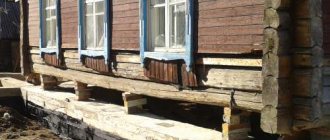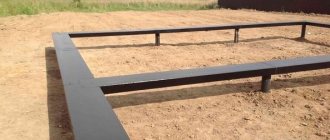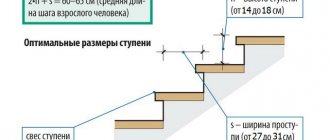Calculation methods
The main elements of this type of foundation are screw piles made of metal, the length and diameter of which may vary depending on the technological requirements and the expected load that they will have to withstand. In specialized companies and design bureaus, you can order a professional, complex calculation of the pile-screw foundation, which will include various parameters and design features, and also take into account the bearing capacity of the soil on the site allocated for the construction of the future house. We propose to use a simplified option and carry out calculations of screw piles, based on practical experience in constructing such structures.
Grillage options for screw piles
Screw piles for foundations with a cast tip
- 108 mm
- 133 mm
| Pile length | Blade diameter | Price from 10 pcs. | Dealer price |
| 1000 mm | 300 mm | 3150 rub. | 3100 rub. |
| 1500 mm | 300 mm | 3400 rub. | 3350 rub. |
| 2000 mm | 300 mm | 3750 rub. | 3700 rub. |
| 2500 mm | 300 mm | 4100 rub. | 4050 rub. |
| 3000 mm | 300 mm | 4500 rub. | 4450 rub. |
| 3500 mm | 300 mm | 4900 rub. | 4850 rub. |
| 4000 mm | 300 mm | 5300 rub. | 5250 rub. |
| 4500 mm | 300 mm | 5700 rub. | 5650 rub. |
| 5000 mm | 300 mm | 6100 rub. | 6050 rub. |
| 5500 mm | 300 mm | 6500 rub. | 6450 rub. |
| 6000 mm | 300 mm | 6900 rub. | 6850 rub. |
Installation cost from 900 rub. for the pile
| Name | Size | Price from 10 pcs. | Dealer price | Installation |
| Heading | 200 mm | 200 rub. | 200 rub. | 0 rub. |
| Heading | 250 mm | 250 rub. | 250 rub. | 0 rub. |
| Pile length | Blade diameter | Price from 10 pcs. | Dealer price |
| 1000 mm | 350 mm | 3700 rub. | 3650 rub. |
| 1500 mm | 350 mm | 3950 rub. | 3900 rub. |
| 2000 mm | 350 mm | 4400 rub. | 4350 rub. |
| 2500 mm | 350 mm | 4850 rub. | 4800 rub. |
| 3000 mm | 350 mm | 5300 rub. | 5250 rub. |
| 3500 mm | 350 mm | 5800 rub. | 5750 rub. |
| 4000 mm | 350 mm | 6300 rub. | 6250 rub. |
| 4500 mm | 350 mm | 6850 rub. | 6800 rub. |
| 5000 mm | 350 mm | 7400 rub. | 7350 rub. |
| 5500 mm | 350 mm | 7950 rub. | 7900 rub. |
| 6000 mm | 350 mm | 8450 rub. | 8400 rub. |
Installation cost from 1100 rub. for the pile
| Name | Size | Price from 10 pcs. | Dealer price | Installation |
| Heading | 200 mm | 300 rub. | 250 rub. | 0 rub. |
| Heading | 250 mm | 400 rub. | 350 rub. | 0 rub. |
Determining the diameter of the supports
Screw piles, which are used when installing foundations for residential and commercial buildings, have a diameter of 57, 76, 89 and 108 mm . This parameter is selected depending on the weight of the finished structure:
- 57 mm - used for the construction of the simplest and lightest structures (fences and fences made of chain-link mesh);
- 76 mm - chosen as the basis for lightweight outbuildings or fences made of wood or corrugated board. The bearing capacity of such elements does not exceed 3000 kg;
- 89 mm - used where the load-bearing load will not exceed 5000 kg. This is an excellent solution for the construction of a one-story building (frame or panel), baths, summer kitchens, sheds and massive fences;
- 108 mm - foundation a site for the construction of a house made of foam blocks, wooden beams, frame (1-2 floors) with light weight. The bearing capacity of screw piles of this diameter reaches 7000 kg.
The diameter of the elements depends on the weight of the building
Object Parameters Settings Manager
The Object Parameters Settings Manager is designed to create a drawing template.
Used to solve the following problems:
- managing the settings of parameters of all program elements (Fig. 1−3);
- using standard and creating custom layers with setting their properties (Fig. 4);
- saving settings in a file for later use in other projects.
| Rice. 1. Settings Manager Menu | ||
Factors affecting the length of supports
The strength of the future structure depends on the correct determination of the length of the piles, and if these important elements of the foundation turn out to be short, the house may sag under its own weight after it is put into operation. The length of the piles is determined taking into account the analysis of the soil and landscape, namely:
- Soil density.
- The difference in height between different points on the site.
Soil density
Support immersion depth
Soil analysis is best carried out on the basis of geological studies of the area. If studies of soil characteristics have not been carried out in a given area, then you can use a simplified method to determine its density.
So, you need to dig a shallow ditch (up to 1 m) at the lowest point of the site. If at such a depth you see a clay mass or sand, then it is better to make a choice in favor of piles, the length of which reaches 2.5 m. If you find low-density rocks (peat), quicksand or groundwater, you will have to continue deepening until you reach hard rocks. Piles are installed here, the length of which is equal to the length of the drill.
Here is a table of the density and bearing capacity of various soils.
| Type of soil | Dense soil | Medium density soil |
| Sand (coarse fraction) | 6 | 5 |
| Sand (middle fraction) | 5 | 4 |
| Sandy loam (dry) | 3 | 2.5 |
| Plastic sandy loam (wet) | 2.5 | 2 |
| Sand (fine fraction) | 4 | 3 |
| Wet sand (fine fraction) | 3 | 2 |
| Clay | 6 | 2.5 |
| Clay wet | 4 | 1 |
| Loam | 3 | 2 |
| Loam wet | 3 | 1 |
The difference between the heights of the site
As mentioned earlier, in order not to make a mistake with the piles and correctly calculate their length, it is necessary to determine the difference in height of different points on the site. If you are convinced that such a difference exists and, according to the density of the soil, piles 2.5 m long are suitable, then they must be mounted in the very top row.
Those supports that will be fixed in lowlands should be longer by the difference in height between the points of their installation. The difference is calculated using a water level or level using a plumb line and tape measure. If there is a significant difference in height (more than 0.5 m), it is recommended to add 50 cm to the resulting length of the foundation piles, since in the lowest places their height may not reach 20 cm.
(function(w, d, n, s, t) { w[n] = w[n] || []; w[n].push(function() { Ya.Context.AdvManager.render({ blockId: "RA-510923-1", renderTo: "yandex_rtb_R-A-510923-1", async: true }); }); t = d.getElementsByTagName("script")[0]; s = d.createElement(" script"); s.type = "text/javascript"; s.src = "//an.yandex.ru/system/context.js"; s.async = true; t.parentNode.insertBefore(s, t) ; })(this, this.document, "yandexContextAsyncCallbacks");
Accounting for height differences
Calculation method
The number of screw piles is calculated taking into account the dimensions and weight of the house that will be installed on the foundation . As a rule, the distance between piles can be:
- up to 2 m if a structure is built from aerated concrete and foam concrete blocks or slabs;
- up to 3 m, if it is planned to build a wooden house from timber, logs, etc.;
- up to 2.5 m - also chosen for wooden structures. They also work with such piles in regions where there is a large wind load;
- up to 3.5 m - for the construction of lightweight fences and fences.
Construction of a house from timber
To correctly determine the number of supports for a pile-screw foundation, the following operations should be carried out :
- draw up a project for the future foundation or first level of construction;
- place screw supports at each corner of the future building;
- install piles where the load-bearing partitions of the house will intersect;
- between the located piles it is now necessary to install additional piles along the perimeter of the load-bearing walls with the condition that the distance from one to another element does not exceed what was previously recorded (taking into account the weight and type of building);
- the remaining space for the foundation is filled with piles so that the distance between adjacent supports does not exceed that specified in the calculations (2 - 3 m);
- where a stove or fireplace will be installed, provide at least a pair of screw supports, again, taking into account the size of the heating structure, otherwise a critical load on the foundation cannot be avoided;
- in case a terrace or any other extension is built, the locations for fixing the supporting elements are designated according to the previously agreed upon principle, taking into account the optimal step distance;
- Now that the distance between the piles has been determined, all that remains is to count all the screw supports marked on the plan diagram.
How to determine the atmospheric load on a building?
To calculate the wind load you need to use the formula: V=(40+15h)S, in which:
- h is the total height of the building (from the bottom point to the ridge);
- S is the area of the building.
Snow load depends on the climatic conditions of a particular region. Here are the average data for different territories:
- Black Earth and southern regions - 50 kg per m2;
- Middle strip - 100 kg/m2;
- Latitude from Arkhangelsk to Novgorod - 150 kg/m2;
- North of Arkhangelsk - 200 kg/m2;
- Siberia - 350 kg/m2.
Expert advice! In the case of building a foundation for a one-story house, the obtained data must be multiplied by 1.3, for a two-story house - by 2, and the result added to the total weight of the building structure.
Calculating the grillage
The pile base can be constructed from only supports, on which the lower frame of the building is laid.
To ensure that the load on the supports from the weight of the structure is distributed more evenly, they resort to making a grillage.
A grillage is a beam or reinforced concrete slab that horizontally connects the tops of each screw element. Pile-grillage foundations are equally well suited for the construction of wooden and foam block buildings. The strip grillage can be monolithic or prefabricated, the main thing is that it is cast from concrete, the grade of which is not lower than 150.
In order for the grillage to be properly constructed and create a strong connection between the screw elements, you need to correctly calculate its dimensions. There are a number of special calculations, but we will limit ourselves to the minimum dimensions of the binding tape:
Foundation with reinforced concrete grillage
- Height – 30 cm.
- Width – 40 cm.
To give the grillage the necessary rigidity, it must be reinforced with longitudinal and transverse reinforcement (10-12 mm in diameter). The rods are connected using wire according to the principle of an armored belt. The distance from the reinforcement to the edge of the grillage must be at least 2.5 cm so that the metal rods are completely sealed with concrete mortar and are not subject to corrosive processes.
The connection of the grillage with the supports can be rigid, when its reinforcement is connected to the pile rods, or loose, when the grillage lies on the foundation supports without additional support. In both cases, the load is distributed evenly between the piles.
Prefabricated strip foundations on a natural foundation and walls made of FBS and FBP blocks
- Calculation of strip foundation deformations, design and layout in a controlled automatic mode of foundation slabs on the layout diagram (Fig. 32−36).
- Possibility of continuous or discontinuous layout of foundation slabs.
- Semi-automatic layout of foundation blocks in wall patterns.
- Convenient service tool for editing the layout of blocks and foundation slabs (Fig. 37).
- Layout (in semi-automatic mode) of rand beams on the foundation layout diagram.
- Automatic marking of wall blocks and rand beams on the drawing in accordance with the positions in the specification.
- Minimizing the volume of monolithic seals when laying out prefabricated blocks and foundation slabs.
- Automatic calculation of the consumption of monolithic concrete in the development of walls made of prefabricated blocks and in prefabricated strip foundations, taking it into account in the specifications.
- A complete set of specifications for layout diagrams.
- Formation and automatic drawing of the section according to the marker data of the prefabricated strip foundation (Fig. 38).











